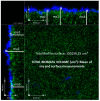Role of Biofilms in Children with Chronic Adenoiditis and Middle Ear Disease
- PMID: 31086039
- PMCID: PMC6571864
- DOI: 10.3390/jcm8050671
Role of Biofilms in Children with Chronic Adenoiditis and Middle Ear Disease
Abstract
Chronic adenoiditis occurs frequently in children, and it is complicated by the subsequent development of recurrent or chronic middle ear diseases, such as recurrent acute otitis media, persistent otitis media with effusion and chronic otitis media, which may predispose a child to long-term functional sequalae and auditory impairment. Children with chronic adenoidal disease who fail to respond to traditional antibiotic therapy are usually candidates for surgery under general anaesthesia. It has been suggested that the ineffectiveness of antibiotic therapy in children with chronic adenoiditis is partially related to nasopharyngeal bacterial biofilms, which play a role in the development of chronic nasopharyngeal inflammation due to chronic adenoiditis, which is possibly associated with chronic or recurrent middle ear disease. This paper reviews the current evidence concerning the involvement of bacterial biofilms in the development of chronic adenoiditis and related middle ear infections in children.
Keywords: Biofilm; adenoids; nasopharynx; otitis; upper respiratory tract infections.
Conflict of interest statement
The authors declare they have no conflict of interest.
Figures



References
-
- Gates G.A., Klein J.O., Lim D.J., Mogi G., Ogra P.L., Pararella M.M., Paradise J.L., Tos M. Recent advances in otitis media. 1. Definitions, terminology, and classification of otitis media. Ann. Otol. Rhinol. Laryngol. Suppl. 2002;188:8–18. - PubMed

